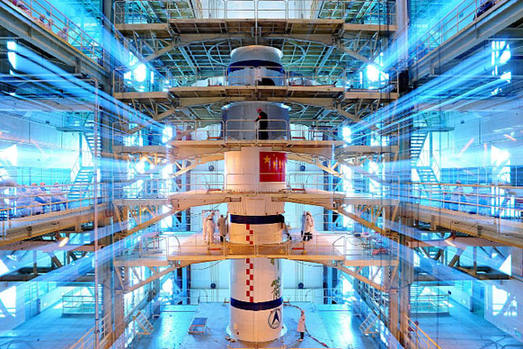– The Successful Docking of the Shenzhou-8 Spacecraft with Tiangong-1
By LU RUCAI
|
 |
| The unmanned Shenzhou-8 joins up with Tiangong-1 on November 3, 2011. |
ON September 29, 2011 the 8.5-ton target vehicle Tiangong-1 was launched successfully, and now orbits the Earth at a distance of 350 km. It has now been 10 years since the launch of Shenzhou-1 on November 20, 1999, and on November 1 of this year Shenzhou-8 blasted off skywards, tracking for thousands of kilometers before docking with Tiangong-1 on November 3.
This marks the completion of the first rendezvous and docking mission of China’s manned space engineering project, and this success will pave the way for later work on the international space station. China has become the third country to master docking technology after Russia and the U.S. According to its schedule, after completing its missions Shenzhou-8 will separate from Tiangong-1, which will then move out to a higher orbit in wait for the upcoming Shenzhou-9 and Shenzhou-10. And Shenzhou-8 will return to the Earth after the undocking.
Zhang Bonan, chief designer of Shenzhou-8, remarked that all the equipment of the spacecraft was independently designed and developed by China. It has been less than seven years since work began on the project, two years of which were dedicated to final-phase research. The average age of the Shenzhou-8 team is 32, while the youngest chief designer is a mere 26 years old.
Rendezvous and docking for spacecrafts is commonly recognized as a technical challenge in the field of aerospace engineering. It requires extreme accuracy in the positioning and orientation of two high-speed spacecraft in a near-Earth orbit. After docking, they maneuver and act as one object. Whole series of complicated technological procedures are involved in the process.
On this occasion, China succeeded in performing an unmanned docking, relying solely on the spacecraft’s automatic controls and ground control instructions. It was regarded as an extremely challenging task. As Tim Robinson, a well-known aerospace observer, told the Xinhua News Agency, the automated docking system China used is different from the manual system used by the U.S. in its docking missions and reduces the risks for astronauts.
Tong Xudong, director of the Manned Space Engineering Office of the CASC (China Aerospace Science and Technology Corporation), pointed out that the launch of Shenzhou-8 is the second stage of a quartet mission, with the launch of Tiangong-1 being the first step and the planned launches of Shenzhou-9 and Shenzhou-10 being the third and fourth moves respectively.
